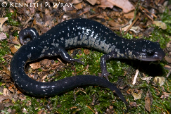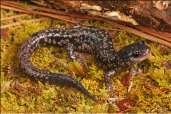Savannah Slimy Salamander (Plethodon savannah)
Description: Average sized among the Coastal Plain species of the slimy salamander complex, the Savannah slimy salamander reaches total lengths of 5.5 inches. It has a black background with many white spots (some, but few spots may be brassy) scattered on the back, abundant white spotting on its sides and the upper surfaces of its limbs, and a moderate amount of spotting on the cheeks, chin, and sides of the head; its belly possesses few white spots.
Habitat: This species inhabits the floor of deciduous forests, where it is found under logs and rocks during the day. Individuals are most active at night, especially under moist conditions. It likely avoids unsuitable cold and dry conditions by seeking refuge underground sites. It is unknown if this species is resilient to habitat disturbance.
Range: This species is known only from only from Burke, Jefferson, and Richmond counties, in Georgia, where it occurs in the low hills between Brier Creek and the Savannah River, east of the city of Waynesboro.
Found in these States:
GA
Diet: Unknown, but as with other Plethodon species, feeding likely takes place at night under moist conditions. Prey items likely include a range of invertebrates, especially insects.
Reproduction: Eggs are laid in rotting logs, underground, or in rock crevices. This species develops directly without a larval stage.
Status: Listed as Data Deficient since there is very little information on its extent of occurrence, population status, ecological requirements, and threats. This lack of data makes it difficult to discern if this species could qualify for a threatened category or is suitable for Least Concern, therefore Data Deficient is the most appropriate category
»» Kingdom: Animalia - Animals
»» Phylum: Chordata - Chordates
»» Subphylum: Vertebrata - Vertebrates
»» Class: Amphibia - (Amphibians)
»» Order: Caudata - Salamanders
»» Family: Plethodontidae - Lungless Salamanders
»» Genus: Plethodon
»» Species: Plethodon savannah - Savannah Slimy Salamander
This article uses material from the Wikipedia article "Savannah Slimy Salamander", which is released under the Creative Commons Attribution-Share-Alike License 3.0. Content may have been omitted from the original, but no content has been changed or extended.
|










